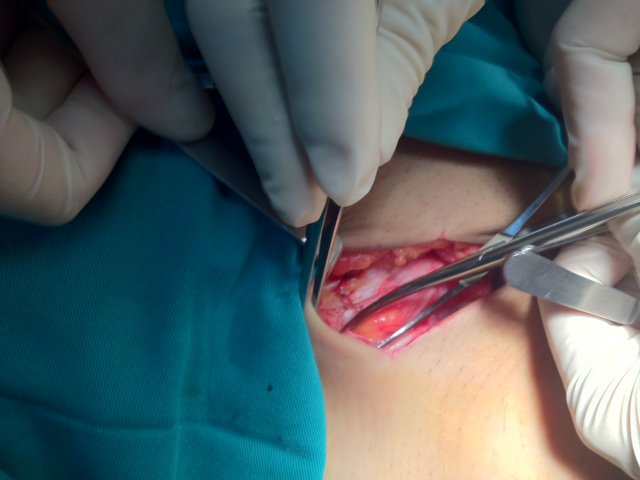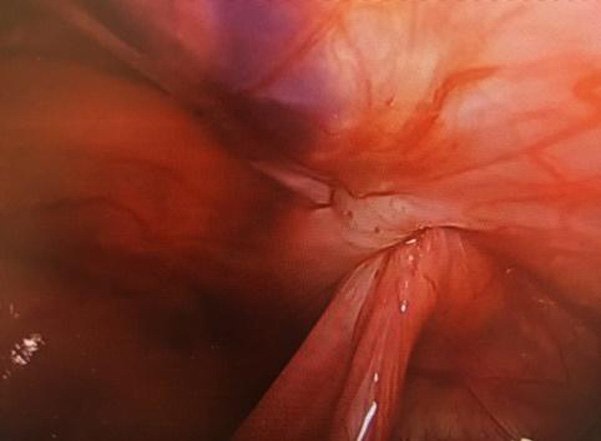What you need to know about intestinal prolapse in children
The article was professionally consulted by Specialist Doctor II Tran Van Trong - Specialist in Pediatric Surgery, Plastic Surgery - Aesthetics - Department of General Surgery, Vinmec Danang International Hospital
Intestinal prolapse in children is a common disease, especially in boys. This is not a dangerous disease if detected and treated in time. However, in case the disease is not treated early, it will cause dangerous complications such as intestinal obstruction, bowel necrosis, mesenteric...
1. What is intestinal prolapse in children?
Intestinal prolapse or inguinal hernia occurs when part of the intestine protrudes beyond the normal limits of the abdominal wall. As a result, the abdomen swells and causes pain when coughing, bending over, or lifting heavy objects.
During the fetal development in the last months of the baby boy, there will be the formation of a tunnel (tube) from the abdomen to the bottom (inguinal, scrotum). This tube is the thin membrane lining the inside of the abdomen. Normally, this tube will close on its own in the last month, when not self-closing, the intestine can easily prolapse causing intestinal prolapse or inguinal hernia.
A disease that prolapses into the abdominal wall at the umbilicus is called an umbilical hernia, because the incomplete development of the abdominal wall at the umbilicus makes this position of the abdominal wall thinner and weaker than a normal child. , the intestine will prolapse into this position, also known as umbilical hernia or umbilical cord prolapse or umbilicus. But among them, inguinal prolapse is more common.

Bệnh sa ruột ở trẻ em cần được điều trị sớm
2. Symptoms of intestinal prolapse in children
The usual signs and symptoms of prolapse in children are the result of a weakness in the abdominal wall at birth. Sometimes intestinal prolapse in children is only seen when the child is fussy, coughing, or straining to urinate. Occasionally, children will show signs of irritability and less appetite than usual.
Intestinal prolapse can cause intestinal obstruction because the intestines pass through the narrow place, cutting off blood flow to the intestines, causing severe intestinal pain. In addition, there are some other signs and symptoms such as nausea, fever, sudden and rapidly increasing pain, the hernia turns purple, it is too late.
Intestinal prolapse can cause intestinal obstruction because the intestines pass through the narrow place, cutting off blood flow to the intestines, causing severe intestinal pain. In addition, there are some other signs and symptoms such as nausea, fever, sudden and rapidly increasing pain, the hernia turns purple, it is too late.

Trẻ có biếu hiện quấy khóc khi đi tiểu là dấu hiệu của bệnh sa ruột
3. Treatment of intestinal prolapse in children
A physical examination is essential to diagnose intestinal prolapse in children. Your doctor may check for a bulge in the groin area (inguinal area). However, in cases where the diagnosis is not obvious, the doctor will order imaging tests such as abdominal ultrasound, CT scan or MRI to help visualize the condition more accurately.
Does the treatment of prolapse require surgery? In fact, clinical and treatment specialists have shown that the only treatment for intestinal prolapse in children is surgery. There are two types of hernia surgery as open hernia surgery and laparoscopic surgery:
Open hernia surgery: Surgery is performed under general anesthesia combined with regional anesthesia. The surgeon will make an incision where the hernia occurred and push the protruding tissue into the abdomen. The surgeon then stitches the weakened area back together, without reinforcing it with a synthetic mesh. Next, it will be closed with stitches, which can be combined with cosmetic stitches, bio-glue, and limited surgical scars for children later. After 6 hours of surgery, the child can return to normal walking, but it is necessary to keep the incision dry for 1 week for the wound to heal well and to limit the infection of the incision.

Phẫu thuật thoát vị mở
Laparoscopic surgery: In this minimally invasive procedure, general anesthesia is required. The surgeon will make a small incision in the abdomen. The CO2 that will be injected into the abdomen is used to inflate the abdomen, which can make the internal organs easier to see on a computer screen. A small tube equipped with an endoscope with a camera attached is inserted into the incision. Through the images sent from the camera, the surgeon will use the endoscope to bring the intestines back to the abdomen and then use a surgical needle to tighten the neck of the hernia.
Laparoscopic surgery can cause less discomfort and scarring and can lead to a quicker return to normal activities for adults. In children, for doctors specializing in pediatric surgery, there is not much difference between open surgery and laparoscopic surgery when combined with plastic surgery.

Mổ nội soi thoát vị bẹn
4. Complications of intestinal prolapse in children
The most feared complication is intestinal obstruction, bowel necrosis (death of a part of the intestine that is blocked), sometimes life-threatening. If the hernia is trapped in a weak spot in the abdominal wall, it can cause intestinal obstruction, leading to damage to the herniated intestine, sometimes requiring resection of the bowel if detected late and not treated promptly.
Therefore, when detecting that a child has symptoms of intestinal prolapse, parents should not let the child be too active. In particular, it is necessary to take the child to the doctor as soon as possible so that the disease can be diagnosed in time and treated early to help the child avoid dangerous complications caused by the disease. Therefore, intestinal prolapse in children is not a dangerous disease if detected and treated promptly.
Để đặt lịch khám tại viện, Quý khách vui lòng bấm số HOTLINE hoặc đặt lịch trực tiếp TẠI ĐÂY. Tải và đặt lịch khám tự động trên ứng dụng MyVinmec để quản lý, theo dõi lịch và đặt hẹn mọi lúc mọi nơi ngay trên ứng dụng.






